

Search - All. Home Science Activity: Make a Paper Circuit. Do you like arts and crafts projects like drawing, painting, cutting shapes out of construction paper, or origami?
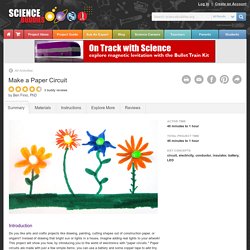
Instead of drawing that bright sun or lights in a house, imagine adding real lights to your artwork! Let It Glow Holiday Cards. Favorited Favorite 4 Introduction.
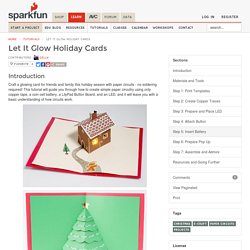
Bare Conductive Musical Painting. Hello everybody!
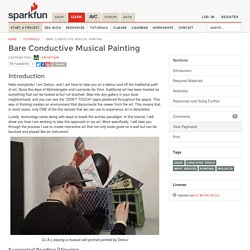
I am Detour, and I am here to take you on a detour and off the traditional path of art. Since the days of Michelangelo and Leonardo da Vinci, traditional art has been treated as something that can be looked at but not touched. Step into any gallery in your local neighborhood, and you can see the “DON’T TOUCH” signs plastered throughout the space. This way of thinking creates an environment that disconnects the viewer from the art. This means that, in most cases, only ONE of the five senses that we can use to experience art is stimulated.
Luckily, technology came along with ways to break the archaic paradigm. The Great Big Guide to Paper Circuits. Favorited Favorite 13 Introduction Paper circuits are becoming more and more popular in the hobby electronics world.
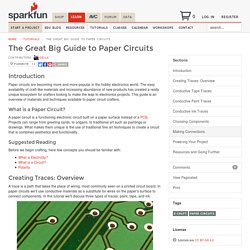
The easy availability of craft-like materials and increasing abundance of new products has created a really unique ecosystem for crafters looking to make the leap to electronics projects. Origami Paper Circuits. Getting Started We love paper circuits!
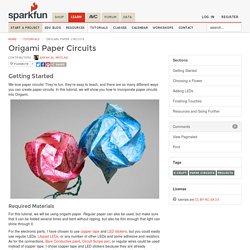
They’re fun, they’re easy to teach, and there are so many different ways you can create paper circuits. In this tutorial, we will show you how to incorporate paper circuits into Origami. Required Materials. Make It @ Your Library. DESIGN SQUAD . Dance Pad Mania. Build a dance pad that lets you use your feet to sound a buzzer or flash a light. 1.5-volt AA battery AA battery holder (optional) Aluminum foil Bulb holders for light bulbs (enough for half the group) Buzzers (enough for half the group) 2 11 x 17-inch sheets of corrugated cardboard (per team) Duct tape Electrical wire (22-gauge works well) Light bulbs that can run on a 1.5-volt AA battery Plastic wrap Scissors Wire strippers Divide your group into teams of two.
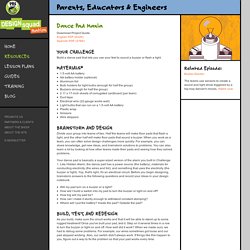
Half the teams will make floor pads that flash a light, and the other half will make floor pads that sound a buzzer. When you work as a team, you can often solve design challenges more quickly. For example, you can share knowledge, get new ideas, and brainstorm solutions to problems. Your dance pad is basically a super-sized version of the alarm you built in Challenge 1. Light-up Poof Books. Easy Origami Star of David Folding Instructions. This is an easy origami star of david that can be folded with a rectangular paper or even a dollar bill.
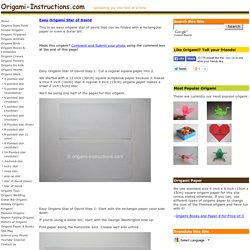
Made this origami? Comment and Submit your photo using the comment box at the end of this page! Easy Origami Star of David Step 1: Cut a regular square paper into 2. We started with a 12 inch (30cm) square scrapbook paper because it makes a nice 4 inch (10cm) star. A regular 6 inch (15cm) origami paper makes a small 2 inch (5cm) star. We'll be using one half of the paper for this origami. Easy Origami Star of David Step 2: Start with the rectangle paper color side down. If you're using a dollar bill, start with the George Washington side up. Fold paper along the horizontal axis. Origami 4-Pointed Star Folding Instructions - How to fold a 4-Pointed Star Origami. This origami 4-pointed star looks like a windmill and requires some patience!

It's funny how you make fold after fold and don't see the shape of a star until the very last fold! LED Chandelier. LED Origami. Bare Conductive Pen (10ml) Voltage Village - Glowing House Set - Bare ConductiveBare Conductive. Step 21 Troubleshooting If your LEDs don't turn on or off at this stage don't fret, there's a few things you can check: 1.
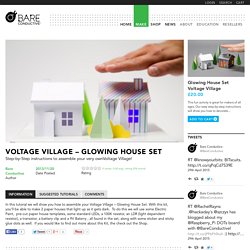
Is your paint dry? If not leave it overnight or put it in a warm place until it's completely dry. 2. 3. 4. SparkTruck's Simple Circuit Town! - All - English. This workshop explores imagining a city, sketching the city, building the city using cardboard and tape and then illuminating the city with LED lights.
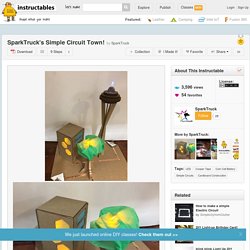
In about 2 hours, this project covers topics ranging from geometry, simple circuits and urban design, all through a fun hands-on experience that incorporates both low-tech building and simple circuits. This activity can be aligned to multiple subject areas and grade levels: math, social studies, language arts and more! This workshop requires several facilitators (recommended = 2). You will need at least one facilitator to help with troubleshooting the simple circuits, and at least one facilitator to help with building the city.
Project Daffodil Uses Electronics to Create Interactive Pop-Up Books. View All This exhibit will be appearing at the 10th annual Maker Faire Bay Area. Don’t have tickets yet? Digital Is. As a professional artist, deepening the ways in which seemingly disparate objects and processes are interconnected through locating, and mapping their intersections has been one of the main elements of my studio practice. The Fab Lab tools and working processes create an environment that is well suited to investigating those types of intersections. In an effort to integrate Fab Lab tools centered on craft, and studio-based processes into the classroom, I have been working to implement a Mobile MakerCart at a project-based K-8 charter school. In addition to introducing craft-based physical computing projects to the children, a guiding principle behind the MakerCart is to give teachers the opportunity to develop familiarity with the MakerCart’s tools and processes in order to be able to envision the ways in which they might be able to develop their own curriculum for use in the classroom.
Papercircuits.pdf. Mechanical Iris Card - Improved! Modmischief created this improved version of the mechanical iris greeting card for YuKonstruct's Holiday Card Build Night. This new design solves the issue of the shutter pieces catching on the ends of the brads and simplifies the card construction by making the base card just one piece of cardstock. YuKonstruct is the first makerspace in Canada's north. Our mission is to provide access to shared space, quality tools, available expertise, and a collaborative environment to help makers build anything! Circuit Playground - YouTube. How to Test LED Lights with a Multimeter. Written by: Terry Ligard • edited by: Lamar Stonecypher • updated: 1/16/2010 Anybody experimenting with robotics will need to know how to test an LED light.
For this, one requires a multimeter and the particular LED to be tested. Obtaining the voltage consumption of the LED will aid one in assessing the required battery life needed to sustain the circuit. Testing an LED with a MultimeterIn my previous article about LEDs, I discussed the distinct details of the LED. Conductive Poetry. First thing you'll want to do is to choose a short poem or sentence, ideally one that can easily be modified by changing a few words. I picked e.e. cummings' "i carry your heart with me, i carry it in my heart," because it leaves a ton of options. Using a pencil, sketch out the sentence on a piece of heavy paper, omitting your changeable words. Make sure to leave a blank space (no writing) in place of the missing words so there is room for the picture pieces you'll create later.
At the edges of the blank spaces, make large circles as landing pads for the legs of the word blocks to rest on. They should be roughly 1/2-1" apart. It's important to have all of the letters connect so that the circuit can be completed by the inserted words. Draw a line from either end of the poem to the edge of the paper and make a circle there too.
Bare Conductive Paint - 50mL ID: 1305 - $29.95. Jie Qi – Electronic Popables. Electronic Popables is an interactive pop-up book that sparkles, sings, and moves. The book integrates traditional pop-up mechanisms with thin, flexible, paper-based electronics and the result is a book that looks and functions much like an ordinary pop-up with the added element of dynamic interactivity. Paper Engineering and Pop-ups For Dummies: Rob Ives: 9780470409558: Amazon.com: Books. How to Make a Tunnel Book. This card is two tunnel books, hinged together in the middle, with a pop out back. Top view to show accordion pleats. Flattened view showing picture layers. Tunnel Book Tutorial Here is one way to make a tunnel book. In some versions the side accordions are made as a continuous fold, causing the middle picture layers to sit at an angle to the front of the card. Seven Flower Pop Up Card.
Wp-content/uploads/2011/12/GiftBoxInstructions.pdf. Wp-content/uploads/2011/12/GiftBoxSheetB.pdf. Wp-content/uploads/2011/12/GiftBoxSheetA.pdf. Wp-content/uploads/2009/06/gerbera-instructions.pdf. Wp-content/uploads/2009/06/gerberasheetb.pdf. Wp-content/uploads/2009/06/gerberasheeta.pdf. Making Books with Children. Making Books Around the World and Across the Curriculum Explore the ways cultures preserve their stories as you learn how to make scrolls from Africa, slat books from ancient China, palm leaf books from Southeast Asia, and accordion books from Mexico and use them across the curriculum. The session begins with a viewing of Susan's collection of authentic books from around the world and ends with hands-on activities. This is Susan's most popular workshop. Making Books for Ancient Civilizations Learn how ancient civilizations preserved their knowledge.
Making Books for Math and Science Learn a variety of book forms for use in math and science. Making Books for American History Learn what kinds of books were made in Colonial America and after for both adults and children and how to make them. Tinkering.exploratorium.edu/sites/default/files/Instructions/paper_circuits.pdf.
Circuit Ideas.